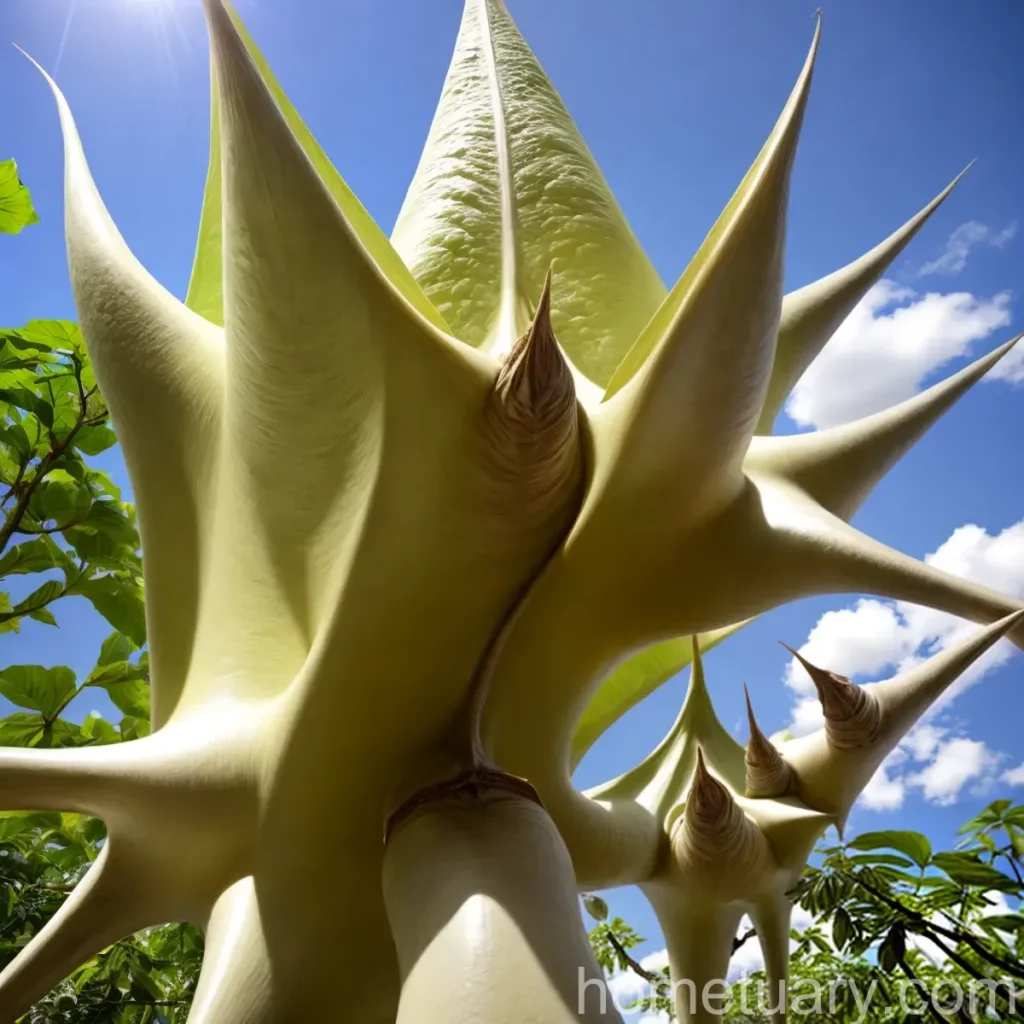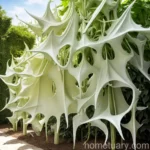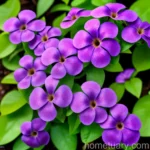Maikoa (Brugmansia suaveolens): A Complete Plant Care Guide
Brugmansia suaveolens, commonly known as Maikoa, is a stunning flowering plant that is revered for its beautiful and aromatic blooms. In this comprehensive guide, we will delve into the intricate details of Maikoa plant care, covering all the essential aspects from cultivation and propagation to pruning, diseases, and common pests. Whether you are a novice gardener or an experienced horticulturist, this detailed care guide will provide you with the knowledge and insights needed to grow and care for the majestic Maikoa plant.
What is Maikoa (Brugmansia suaveolens)?
Maikoa, scientifically known as Brugmansia suaveolens, is a woody shrub or small tree native to South America, particularly the Andes region. It belongs to the Solanaceae family, which includes a diverse array of plants such as tomatoes, potatoes, and other ornamental flowering species. Maikoa is distinguished by its large, pendulous, trumpet-shaped flowers that release a sweet, intoxicating fragrance, especially during the nighttime.
Key Takeaways – Maikoa (Brugmansia suaveolens)
Before delving into the specifics of Maikoa plant care, let’s highlight some key takeaways about this captivating plant:
- Common Name: Maikoa
- Scientific Name: Brugmansia suaveolens
- Family: Solanaceae
- Native Region: South America, particularly the Andes
- Characteristics: Large, pendulous trumpet-shaped flowers, sweet fragrance
- Cultural Use: Ornamental plant, traditional medicinal uses
- Toxicity: Contains toxic compounds
- Growth Habit: Woody shrub or small tree
- Flowering Season: Typically blooms from late spring to early fall
Now that we have an overview of the plant let’s dive into the essential aspects of Maikoa plant care, covering its cultural uses, water, sunlight, fertilizer, soil, pruning, propagation, container gardening, common diseases, and pest control.
Cultural Uses
Ornamental Beauty
Maikoa is primarily cultivated for its ornamental value, as its large, pendulous flowers add a touch of elegance and splendor to gardens, landscapes, and indoor spaces. The distinct trumpet-shaped blooms, which can exceed 10 inches in length, make Maikoa a focal point in any setting. Whether grown in containers or planted directly in the ground, Maikoa’s floral display is truly captivating.
Traditional Medicinal Uses
In addition to its ornamental charm, Maikoa has a history of traditional medicinal uses in certain indigenous cultures. However, it’s important to note that all parts of the plant contain toxic compounds, and improper use can lead to severe health issues. As such, any traditional medicinal uses of Maikoa should be approached with caution and under the guidance of qualified healthcare professionals.
Water
Watering Requirements
Maintaining appropriate soil moisture is crucial for the health and vitality of Maikoa plants. As a general guideline, watering should be carried out consistently, ensuring that the soil remains evenly moist but not waterlogged. During the growing season, frequent watering may be necessary, particularly during periods of hot and dry weather. Conversely, during the dormant period or in colder months, a reduction in watering frequency is recommended.
Water Stress Symptoms
Proper watering practices play a pivotal role in preventing water stress in Maikoa plants. Common symptoms of water stress include wilting, yellowing or browning of leaves, and decreased turgidity. By monitoring the moisture levels in the soil and adjusting the watering regimen accordingly, gardeners can mitigate the risk of water stress and help the plants thrive.
Sunlight
Sunlight Needs
Maikoa plants exhibit a preference for ample sunlight, ideally receiving at least 6-8 hours of direct sunlight per day. When grown in outdoor settings, choosing a location with full to partial sun exposure will promote robust growth and abundant flowering. In regions with intense heat, providing some protection from the harsh midday sun can prevent sunburn and heat stress on the plants.
Sunlight Adaptation for Indoor Growth
For indoor cultivation, placing Maikoa plants near south or west-facing windows can provide the necessary light exposure. In settings with limited natural light, supplemental grow lights can be employed to ensure that the plants receive adequate light intensity for healthy growth and blooming.
Fertilizer
Fertilization Methods
A well-balanced and nutrient-rich fertilizer regimen can enhance the growth and blooming performance of Maikoa plants. During the active growing season, applying a high-quality, water-soluble fertilizer with a balanced N-P-K (nitrogen, phosphorus, potassium) ratio or one formulated for flowering plants can support the plant’s nutritional needs. Additionally, incorporating organic matter or compost into the soil can contribute to long-term soil fertility and overall plant health.
Nutrient Requirements
Maikoa plants typically benefit from fertilizers with a balanced N-P-K ratio, such as 10-10-10 or 20-20-20, to promote healthy foliage growth and prolific flowering. The supplemental application of micronutrients, including iron, magnesium, and calcium, can address specific nutrient deficiencies and bolster the plants’ physiological processes.
Soil
Best Soil for Maikoa Plants
An ideal growing medium for Maikoa plants is well-draining, fertile soil with a slightly acidic to neutral pH range. A combination of organic matter, such as compost or peat moss, and coarse materials like perlite or sand can improve soil structure and drainage, ensuring that excess water does not accumulate around the plant’s roots. It’s paramount to avoid compacted or waterlogged soils, as they can lead to root rot and other detrimental conditions.
Soil pH Considerations
The recommended pH range for Maikoa plants is generally between 6.0 and 7.0. Periodic soil testing can provide valuable insights into the pH levels and nutrient availability, allowing gardeners to make necessary adjustments through the application of pH-modifying materials, such as limestone for raising pH or elemental sulfur for lowering pH.
Pruning
Pruning Guide for Maikoa
Pruning is an integral aspect of Maikoa plant care, contributing to maintaining a desirable shape, rejuvenating older growth, and promoting robust flowering. Regular pruning sessions, conducted in late winter or early spring, can remove dead or damaged branches, improve air circulation, and stimulate the development of new growth.
Pruning Frequency
A general guideline for Maikoa pruning frequency is to conduct annual pruning sessions after the winter dormancy period. Additionally, light pruning throughout the growing season can control the plant’s size, encourage branching, and shape the overall canopy. However, it’s essential to exercise caution when pruning, as all parts of the plant contain toxic compounds that can cause skin irritation and other adverse effects if handled improperly.
Propagation
Propagation Techniques
1. Stem Cuttings: Propagating Maikoa plants from stem cuttings is a popular and effective method. Selecting healthy, non-flowering stems, usually 8-12 inches long, and removing the lower leaves before placing them in a well-draining, moist propagation medium can initiate root development within a few weeks.
2. Layering: Another propagation method involves air layering, where a portion of a healthy stem is wounded, treated with rooting hormone, and wrapped with a moist propagation medium and plastic film. This technique encourages the formation of roots at the wounded site, enabling the detachment of the rooted section for independent growth.
3. Seed Propagation: While less common due to the extended time to maturity, Maikoa plants can be grown from seeds. Harvesting the seeds from mature pods and sowing them in a suitable growing medium under controlled conditions can lead to the germination and establishment of new plants.
Container Gardening
Container Selection
When cultivating Maikoa plants in containers, choosing a spacious and well-draining pot is essential for accommodating the plant’s extensive root system and preventing waterlogging. Selecting containers with drainage holes at the base can facilitate proper moisture management, while larger containers provide ample space for root development and growth.
Indoor Maikoa Care
For indoor cultivation, positioning the containers in bright, indirect light and maintaining consistent humidity levels can create an optimal environment for Maikoa plants. Additionally, monitoring the soil moisture and following a regular watering schedule can support the plants’ vitality in indoor settings.
Common Diseases
Disease Diagnosis
Maikoa plants are susceptible to various diseases, including fungal infections, bacterial diseases, and viral pathogens. Common symptoms of disease infestations may include leaf spots, wilting, yellowing of foliage, or overall decline in plant vigor. Timely diagnosis of the specific disease and its causal agent is crucial for implementing targeted treatment measures and preventing the spread of infections.
Disease and Treatment
1. Leaf Spot: Fungal leaf spot diseases can be managed through cultural practices, such as promoting air circulation, reducing leaf wetness, and avoiding overhead watering. Additionally, applying fungicidal treatments can provide a preventive barrier against leaf spot pathogens.
2. Powdery Mildew: Powdery mildew infections can be mitigated through the use of fungicidal sprays, such as neem oil, sulfur-based products, or horticultural oils. Additionally, maintaining adequate spacing between plants and reducing humidity levels can minimize the risk of powdery mildew outbreaks.
3. Root Rot: Preventing root rot in Maikoa plants necessitates optimizing soil drainage, avoiding waterlogged conditions, and using well-draining potting mixes. Application of fungicidal drenches or biological control agents can help manage root rot pathogens and promote root health.
Pest Control
Common Pests
Maikoa plants are susceptible to infestations from various pest species, including aphids, whiteflies, spider mites, and caterpillars. These pests can cause damage to the foliage, stems, and blooms, leading to aesthetic deterioration and potential decline in plant health if left unchecked.
Pest Management Strategies
1. Aphid Control: Introducing natural predators of aphids, such as ladybugs or lacewings, can help mitigate aphid populations. Additionally, employing insecticidal soaps or neem oil sprays can effectively manage aphid infestations while minimizing the impact on beneficial insects.
2. Whitefly Management: Utilizing yellow sticky traps and applying insecticidal sprays targeted at whiteflies can contribute to reducing their populations and preventing excessive damage to Maikoa plants.
3. Spider Mite Mitigation: Creating a less hospitable environment for spider mites by increasing humidity levels, regular foliar rinsing, and application of horticultural oils can aid in controlling these troublesome pests.
Botanist’s Tips
Expert Insight and Recommendations
To further enrich the Maikoa plant care experience, we sought insights and recommendations from seasoned botanists and horticultural experts. Here are some invaluable tips to enhance the cultivation and management of Maikoa plants:
- Nutrient Management: Maintaining a balanced fertilization regimen, with an emphasis on phosphorus and potassium for flowering promotion, can elevate the overall performance of Maikoa plants.
- Weather Considerations: Monitoring temperature fluctuations and protecting the plants from frost or extreme cold events is essential, particularly for regions with suboptimal climate conditions.
- Mulching Benefits: Applying a layer of organic mulch around the base of the plants can conserve soil moisture, suppress weed growth, and insulate the root zone during temperature extremes.
Fun Facts
Intriguing Tidbits about Maikoa
Delving into the realm of fascinating botanical trivia, let’s uncover some captivating fun facts about Maikoa plants:
- The trumpet-shaped flowers of Maikoa are renowned for emitting a potent fragrance that intensifies during the evening and night, attracting pollinating moths and other nocturnal insects.
- Maikoa plants have a long history of association with traditional healing practices in certain indigenous cultures. However, their potent toxicity demands cautious handling and limited use in herbal remedies.
- Despite their striking beauty and aromatic allure, all parts of Maikoa plants, including the flowers, leaves, and seeds, contain toxic alkaloids with potential adverse effects if ingested or handled improperly.
As we conclude this comprehensive guide to Maikoa plant care, we have explored an array of essential topics, from cultivation and propagation to disease management and pest control. By integrating the insights and recommendations provided, you can embark on a rewarding journey of nurturing and cherishing the captivating beauty of Maikoa plants. Whether adorning an outdoor garden or gracing an indoor sanctuary, the enchanting allure of Maikoa (Brugmansia suaveolens) is sure to captivate the hearts and senses of plant enthusiasts and avid gardeners alike.
For more detailed information and specific guidance, we encourage you to explore the external resources and references provided below. Happy gardening and may your Maikoa plants flourish in splendor and grace!
Links to External Resources
- American Society for the Prevention of Cruelty to Animals (ASPCA) – Brugmansia
- University of Florida IFAS Extension – Brugmansia spp. Angel’s Trumpet
- North Carolina State University – Poisonous Plants
- Royal Horticultural Society (RHS) – Brugmansia
- Missouri Botanical Garden – Brugmansia suaveolens
- University of California Integrated Pest Management – Brugmansia spp.
- Australian National Botanic Gardens – Brugmansia: Factsheet
- Michigan State University Extension – Angel’s Trumpet (Brugmansia spp.)
This marks the conclusion of our in-depth exploration of Maikoa (Brugmansia suaveolens) plant care. We hope that this knowledge empowers you to cultivate vibrant and thriving Maikoa plants with confidence and appreciation for their captivating beauty and captivating allure. Happy gardening!















